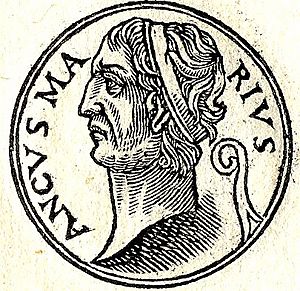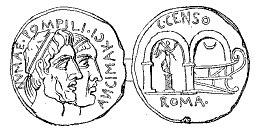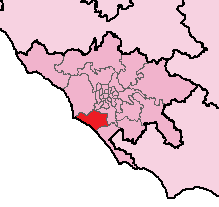Ancus Marcius facts for kids
Quick facts for kids Ancus Marcius |
|
|---|---|
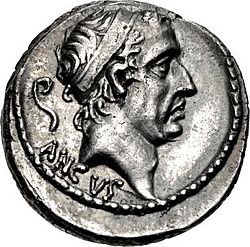
Ancus Marcius depicted on a 57 BC denarius
|
|
| King of Rome | |
| Reign | c. 640–616 BC |
| Predecessor | Tullus Hostilius |
| Successor | Lucius Tarquinius Priscus |
| Father | Numa Marcius |
| Mother | Pompilia |
Ancus Marcius was the fourth legendary king of ancient Rome. He ruled for about 24 years. After the previous king, Tullus Hostilius, died, the Roman Senate chose a temporary leader. This leader then called a meeting for the people to elect a new king. Ancus was known for both fighting wars, like Romulus, and for encouraging peace and religion, like Numa Pompilius.
Many Romans believed that the powerful Marcia family was named after Ancus Marcius. This family was part of the common people, known as plebeians.
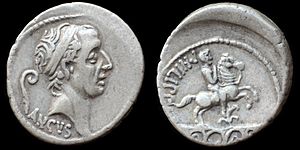 |
|
| Front: diademed head of Ancus Marcius, lituus behind
ANCVS |
Back: equestrian statue on 5 arches of aqueduct (Aqua Marcia)
PHILIPPVS A-Q-V-A-(MAR) |
| Silver denarius coin made by Lucius Marcius Philippus in Rome 56 BC. | |
Contents
Who Was Ancus Marcius?
Ancus Marcius was the son of Marcius and Pompilia. His mother, Pompilia, was the daughter of Numa Pompilius. This meant Ancus Marcius was the grandson of Numa, who was a Sabine.
According to an ancient historian named Festus, Ancus got his name because of his crooked arm. In Latin, the word ancus means "bent."
First Actions as King
When Ancus Marcius became king, his first important act was about religion. He told the Pontifex Maximus, a chief priest, to write down all the rules for public religious ceremonies. These rules came from the writings of his grandfather, Numa Pompilius.
Ancus wanted these rules to be shown to everyone on wooden tablets. This way, people would know how to perform religious rites correctly. During the rule of the previous king, Tullus Hostilius, many of Numa's religious rules had been forgotten or ignored.
Wars and Building Projects
Ancus Marcius fought successful wars against the Latins. He moved many of the defeated Latins to Rome. They settled on the Aventine Hill and became new Roman citizens.
The Latins started the war because they thought Ancus would be peaceful, like his grandfather Numa. They attacked Roman lands first. When Rome asked for things back, the Latins refused. So, Ancus declared war. This was important because it was the first time Rome used special religious rites, performed by priests called fetials, to declare war.
Taking Latin Towns
Ancus Marcius led his army from Rome and captured the Latin town of Politorium. He moved its people to the Aventine Hill in Rome. This was a common Roman practice after wars.
Later, other Latins took over the empty town of Politorium. Ancus captured it again and then destroyed it completely. He also attacked and destroyed the Latin villages of Tellenae and Ficana.
The war then moved to the Latin town of Medullia. This town had strong defenses and many soldiers. After several battles, the Romans won. Ancus returned to Rome with a lot of valuable goods. More Latins were brought to Rome and settled near the Palatine Hill.
Building for Rome
Ancus Marcius made Rome stronger and bigger.
- He added the Janiculum hill to the city. He built a wall around it for protection.
- He connected the Janiculum to the rest of Rome with a wooden bridge over the Tiber River. This bridge was called the Pons Sublicius.
- To protect the bridge, Ancus built strong defenses on the Janiculum side.
- He also took over Fidenae to expand Rome's control across the Tiber.
- On the land side of the city, he dug a defensive ditch called the Fossa Quiritium.
- He built Rome's first prison, which is now known as the Mamertine Prison.
Ancus also made Roman territory larger by founding the port of Ostia. This was Rome's first seaport. He also created salt-works near the port. He took a coastal forest area north of the Tiber, called Silva Maesia, from the Veientes.
To celebrate these successes, he made the temple of Jupiter Feretrius bigger. Historical records suggest that Ancus Marcius celebrated at least one triumph, which was a big parade to celebrate a military victory, over the Sabines and Veientes.
Death and Successor
Ancus Marcius died of natural causes after ruling for 24 years. He had two sons, and one of them was expected to become the next king.
However, a member of Ancus's court named Lucius Tarquinius Priscus had other plans. He made sure that Ancus's sons were out of Rome. This allowed him to arrange an election where he would gain the support of the Roman people.
Ancus Marcius was succeeded by his friend Lucius Tarquinius Priscus. Later, Ancus Marcius's sons assassinated Tarquinius Priscus. During the later Roman Republic and Empire, the important Marcia family claimed that they were descendants of Ancus Marcius.
See also
 In Spanish: Anco Marcio para niños
In Spanish: Anco Marcio para niños


